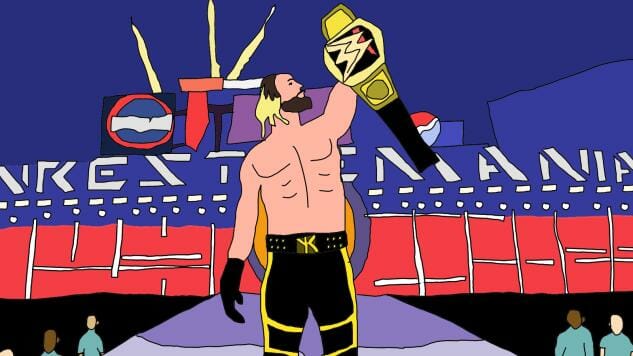TLDR: The WWE is getting its act together, so let’s have fun while it’s still a complete fucking mess.
Unnecessary Extrapolation:
Gang, I’m in a reflective mood. I can’t stop thinking about Mania, I can’t stop thinking about how bad Mania might be, I can’t stop thinking about how many different variations on the same body odor I will inhale during this beautiful time and I can’t stop thinking about how many people might take a dump on the floor of the Megabus I’m taking there.
We’ve established in the past that the WWE is a legion of highly intelligent marketing clowns with a heart of gold, and that there’s a lot of work to be done to get there. So today we look at the last year, from the most exciting moment ever where a greasy Seth Rollins (RIP) burst into a stadium with his briefcase until now, as I slowly stab a picture of Roman Reigns with a ballpoint pen. Shall we?
Wrestlemania 32 is approaching like a heavily scripted freighter train packed to the gills with beefcakes and babes, so it’s the perfect time to take a look at where the decades-old organization is headed. As WWE patriarch and patron saint Vince McMahon ages, sports entertainment has endured a bizarre tug-of-war between old school objectification of their female and minority performers and progress, thanks in part to the involvement of McMahon’s daughter Stephanie’s work as a brand manager and her husband Paul “Triple H” Levesque developing new talent. The biggest night in wrestling is the perfect example of that battle after a year of vocal fan protest has finally seeped into creative decision-making.
The progressive work done between last year’s Wrestlemania and this one is impressive, if inconsistent. We’re talking about the organization that has perpetuated some of the broadest racial stereotypes in the past forty years—look no further than Akeem the African Dream, a white wrestler pretending to be African American, or still-active wrestler Goldust appearing in complete blackface—and WWE isn’t all the way there. Hope for progress has come with writers dialing back on caricatures and turning characters like The New Day, formerly a team that was consistently beat and made to look foolish, into serious contenders with actual storylines.
Beginning as heels whose purpose was to be thrown around for laughs (in spite of containing both a powerlifting champion and a PHD candidate), injuries and hiatuses among top performers like Seth Rollins and John Cena thrust New Day members Xavier Woods, Kofi Kingston and Big E to the forefront with massive fan response. In comparison to the way major talent of past eras like Booker T were routinely set up to fail against white competitors and given little character aside from racial stereotypes, the New Day emerged from a failed gimmick to become one of the most anticipated part of any WWE show. Fans have responded to their new personalities and they’ve been rewarded by the creative department with better booking and placement.
Then there’s the other side of the coin, with former star Hulk Hogan shooting off racist remarks and the press to-do slapping the wrestler’s wrist, and the WWE’s persistent endorsement of outdated caricatures. These weaknesses are particularly noticeable with characters like Rusev, the hulking Cold War wrestler that regularly declares death to America as loudly as in the days of Sgt. Slaughter and his Iraqi pals did in their 1990s heyday. While it’s unclear which figurehead in the WWE is pushing these characters, Vince McMahon is still the one to cross the t’s and dot the I’s. For every problem that’s addressed, there’s another that goes stubbornly ignored, creating confusion and frustration in the fanbase. Who’s running this place?
Another polarizing issue plaguing the WWE is their constantly flip-flopping attitudes toward their female performers (remember the Pink Pussy Butterfly debate?). The organization capitalized on objectifying and making women into props for almost 30 years before treating them seriously in NXT. Absurdly brief matches in the “Divas division” on Raw caused fan uproar in early 2015, prompting brand manager Stephanie McMahon to launch the “Divas Revolution” and call the best women from NXT up to the main roster. This movement extended the length of matches in the Divas division, but so far has been more talk than action. The Divas division has been criticized for its name, which is condescending to performers, and its bright pink butterfly belt, which implies little more than gender in comparison to the traditional championship belts the men get to wear. Add that to an E! reality show and a maximum of one Divas match per pay per view, and there’s a long way to go.
With this yawning split between the old school and the new, Wrestlemania 32 could be the beginning of the end of an era. Vince McMahon won’t have unwavering control over his stable of performers forever, and as Stephanie McMahon and husband Triple H wield growing influence over the company’s brand and NXT development stable, these inconsistencies will likely level out. In fact, some diehard fans are even lamenting the future death of tonedeaf wrestling storylines.
“I’m gonna miss these asinine years someday. Once Vince is gone…it’ll get good again,” said former WWE writer and comedian Matt McCarthy the “We Watch Wrestling” podcast recently. So won’t we all.
Projected Hours of Wrestling Consumed Before Mania: 200 hours
Days Until WrestleMania: 73 days
State of Union: Please recommend me some new wrestling podcasts, I am not worthy!
